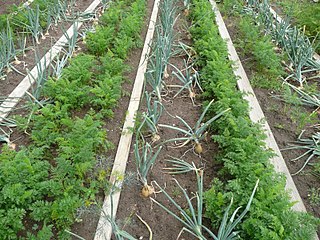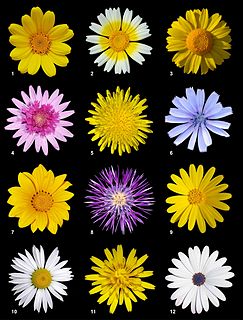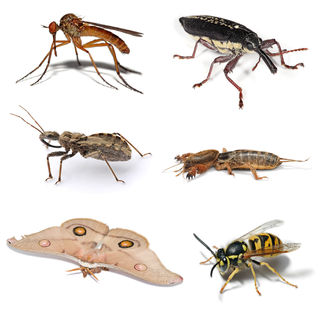Related Research Articles

Companion planting in gardening and agriculture is the planting of different crops in proximity for any of a number of different reasons, including pest control, pollination, providing habitat for beneficial insects, maximizing use of space, and to otherwise increase crop productivity. Companion planting is a form of polyculture.

Centaurea is a genus of between 350 and 600 species of herbaceous thistle-like flowering plants in the family Asteraceae. Members of the genus are found only north of the equator, mostly in the Eastern Hemisphere; the Middle East and surrounding regions are particularly species-rich. In the western United States, yellow starthistles are an invasive species. Around the year 1850, seeds from the plant had arrived to the state of California. It is believed that those seeds came from South America.

A beetle bank, in agriculture and horticulture, is a form of biological pest control. It is a strip planted with grasses and/or perennial plants, within a crop field or a garden, that fosters and provides habitat for beneficial insects, birds, and other fauna that prey on pests.

Beneficial insects are any of a number of species of insects that perform valued services like pollination and pest control. The concept of beneficial is subjective and only arises in light of desired outcomes from a human perspective. In farming and agriculture, where the goal is to raise selected crops, insects that hinder the production process are classified as pests, while insects that assist production are considered beneficial. In horticulture and gardening; pest control, habitat integration, and 'natural vitality' aesthetics are the desired outcome with beneficial insects.

Paper wasps are vespid wasps that gather fibers from dead wood and plant stems, which they mix with saliva, and use to construct water-resistant nests made of gray or brown papery material. Some types of paper wasps are also sometimes called umbrella wasps, due to the distinctive design of their nests.

Midge is a term used to refer to many species of small flies. The term "midge" does not define any particular taxonomic group, but includes species in several families of non-mosquito Nematoceran Diptera. They are found on practically every land area outside permanently arid deserts and the frigid zones. Some midges, such as many Phlebotominae and Simuliidae, are vectors of various diseases. Many others play useful roles as prey items for insectivores, such as various frogs and swallows. Others are important as detritivores, participating in various nutrient cycles. The habits of midges vary greatly from species to species, though within any particular family, midges commonly have similar ecological roles.
A nectar source is a flowering plant that produces nectar as part of its reproductive strategy. These plants create nectar, which attract pollinating insects and sometimes other animals such as birds.
Frass refers loosely to the more or less solid excreta of insects, and to certain other related matter.

Melezitose, also spelled melicitose, is a nonreducing trisaccharide sugar that is produced by many plant sap eating insects, including aphids such as Cinara pilicornis by an enzyme reaction. This is beneficial to the insects, as it reduces the stress of osmosis by reducing their own water potential. The melezitose is part of the honeydew which acts as an attractant for ants and also as a food for bees. This is useful to the lice as they have a symbiotic relationship with ants. Melezitose can be partially hydrolyzed to glucose and turanose the latter of which is an isomer of sucrose.
In agriculture and gardening, a beneficial organism is any organism that benefits the growing process, including insects, arachnids, other animals, plants, bacteria, fungi, viruses, and nematodes. Benefits include pest control, pollination, and maintenance of soil health. The opposite of beneficial organisms are pests, which are organisms deemed detrimental to the growing process.There are many different types of beneficial organisms as well as beneficial microorganisms. Also, microorganisms have things like salt and sugar in them. Beneficial organisms include but are not limited to: Birds, Bears, Nematodes, Insects, Arachnids, and fungi. The ways that birds and bears are considered beneficial is mainly because they consume seeds from plant and spread them through feces. Birds also prey on certain insects that eat plants and hinder them from growing these insects are known as non beneficial organisms. Nematodes are considered beneficial because they will help compost and provide nutrients for the soil the plants are growing in. Insects and arachnids help the growing process because they prey on non beneficial organisms that consume plants for food. Fungi help the growing process by using long threads of mycelium that can reach very long distances away from the tree or plant and bring water and nutrients back to the tree or plant roots.
Economic entomology is a field of entomology, which involves the study of insects that benefit or harm humans, domestic animals, and crops. Insects that cause losses are termed as pests. Some species can cause indirect damage by spreading diseases and these are termed as vectors. Those that are beneficial include those reared for food such as honey, substances such as lac or pigments and for their role in pollinating crops and controlling pests.
Insectary plants are those that attract insects. As such, beneficial insectary plants are intentionally introduced into an ecosystem to increase pollen and nectar resources required by the natural enemies of harmful or unwanted insect pests. Beyond an effective natural control of pests, the beneficial insects also assist in pollination.

A leaf miner is any one of numerous species of insects in which the larval stage lives in, and eats, the leaf tissue of plants. The vast majority of leaf-mining insects are moths (Lepidoptera), sawflies, and flies (Diptera), though some beetles also exhibit this behavior.

A beneficial weed is an invasive plant not generally considered domesticated that has some companion plant effect, is edible, contributes to soil health, adds ornamental value, or is otherwise beneficial. Beneficial weeds include many wildflowers, as well as other weeds that are commonly removed or poisoned.

Calosoma is a genus of large ground beetles that occur primarily throughout the Northern Hemisphere, and are referred to as caterpillar hunters or searchers. Many of the 167 species are largely or entirely black, but some have bright metallic coloration. They produce a foul-smelling spray from glands near the tip of the abdomen. They are recognizable due to their large thorax, which is almost the size of their abdomen and much wider than their head.

Insects or Insecta are hexapod invertebrates and the largest group within the arthropod phylum. Definitions and circumscriptions vary; usually, insects comprise a class within the Arthropoda. As used here, the term Insecta is synonymous with Ectognatha. Insects have a chitinous exoskeleton, a three-part body, three pairs of jointed legs, compound eyes and one pair of antennae. Insects are the most diverse group of animals; they include more than a million described species and represent more than half of all known living organisms. The total number of extant species is estimated at between six and ten million; potentially over 90% of the animal life forms on Earth are insects. Insects may be found in nearly all environments, although only a small number of species reside in the oceans, which are dominated by another arthropod group, crustaceans.
An insect growth regulator (IGR) is a substance (chemical) that inhibits the life cycle of an insect. IGRs are typically used as insecticides to control populations of harmful insect pests such as cockroaches and fleas.

Dinotefuran is an insecticide of the neonicotinoid class developed by Mitsui Chemicals for control of insect pests such as aphids, whiteflies, thrips, leafhoppers, leafminers, sawflies, mole cricket, white grubs, lacebugs, billbugs, beetles, mealybugs, and cockroaches on leafy vegetables, in residential and commercial buildings, and for professional turf management. Its mechanism of action involves disruption of the insect's nervous system by inhibiting nicotinic acetylcholine receptors. In order to avoid harming beneficial insects such as bees, it should not be applied during bloom.

Dryopidae is a family of beetles, commonly named long-toed water beetles, in the superfamily Byrrhoidea. It was described by Gustaf Johan Billberg in 1820.
References
- ↑ Dustin Ambrose (2001). "Friendly insecticides to conserve beneficial insects" (PDF). Zoos' Print Journal.